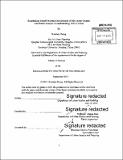| dc.contributor.advisor | Jinhua Zhao. | en_US |
| dc.contributor.author | Zheng, Ruishan, S.M. Massachusetts Institute of Technology | en_US |
| dc.contributor.other | Massachusetts Institute of Technology. Department of Urban Studies and Planning. | en_US |
| dc.coverage.spatial | a-cc--- | en_US |
| dc.date.accessioned | 2016-03-03T21:05:55Z | |
| dc.date.available | 2016-03-03T21:05:55Z | |
| dc.date.copyright | 2015 | en_US |
| dc.date.issued | 2015 | en_US |
| dc.identifier.uri | http://hdl.handle.net/1721.1/101512 | |
| dc.description | Thesis: S.M., Massachusetts Institute of Technology, Department of Urban Studies and Planning, 2015. | en_US |
| dc.description | Cataloged from PDF version of thesis. | en_US |
| dc.description | Includes bibliographical references (pages 102-105). | en_US |
| dc.description.abstract | While the study of Transit-Oriented Development (TOD) in China has been under way since the 1990s, effective examples of TOD in practice remain scarce. This research conducted 41 semi-structured interviews and applied the Policy-Program-Implementation Process (PPIP) model to identify the challenges to TOD implementation-which are found throughout the entire process, from general acceptance, to urban planning capacity and regulations, to government administration and the real estate market. Misunderstanding and incomplete understanding prevent people from fully adopting the idea of TOD. In planning and design, main challenges are in the form of conflicts between current planning regulations and TOD planning techniques. Regarding the public sector, institutional coordination will not become a major barrier once a strong leadership in the municipality is in support of TOD; but there are still barriers in the administrative regulations and financing mechanisms. In the real estate market, great challenges come from developers who hesitate to take the risk to introduce the new type of TOD product. In order to establish successful TODs on the ground in Chinese cities, this research recommends the following solutions. First, effective TOD training programs need to be carried out. Second, the planning codes should be reviewed and revised to establish the legitimacy of TOD. Third, economic incentives and ongoing revenue resources for the government are needed to reassure real estate developers and also provide sustainable economic solutions for the government. Fourth, institutional structure needs to be developed in both administrative and development processes to reduce the institutional barriers and internalize the economic benefits in the TOD implementation. | en_US |
| dc.description.statementofresponsibility | by Ruishan Zheng. | en_US |
| dc.format.extent | 107 pages | en_US |
| dc.language.iso | eng | en_US |
| dc.publisher | Massachusetts Institute of Technology | en_US |
| dc.rights | M.I.T. theses are protected by copyright. They may be viewed from this source for any purpose, but reproduction or distribution in any format is prohibited without written permission. See provided URL for inquiries about permission. | en_US |
| dc.rights.uri | http://dspace.mit.edu/handle/1721.1/7582 | en_US |
| dc.subject | Urban Studies and Planning. | en_US |
| dc.title | Establishing Transit-Oriented Development (TOD) on the ground : case-based analysis of implementing TOD in China | en_US |
| dc.type | Thesis | en_US |
| dc.description.degree | S.M. | en_US |
| dc.contributor.department | Massachusetts Institute of Technology. Department of Urban Studies and Planning | |
| dc.identifier.oclc | 939680800 | en_US |
